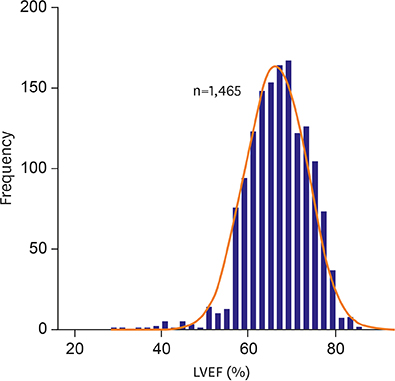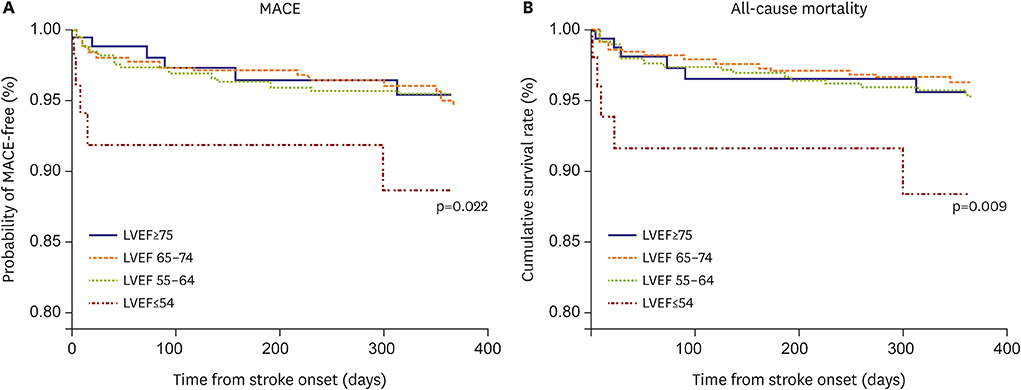Korean Circ J.
2018 Dec;48(12):1148-1156. 10.4070/kcj.2018.0115.
Left Ventricular Ejection Fraction Predicts Poststroke Cardiovascular Events and Mortality in Patients without Atrial Fibrillation and Coronary Heart Disease
- Affiliations
-
- 1Department of Neurology, Soonchunhyang University School of Medicine, Seoul, Korea. kblee@schmc.ac.kr
- 2Department of Cardiology, Soonchunhyang University School of Medicine, Seoul, Korea.
- KMID: 2424565
- DOI: http://doi.org/10.4070/kcj.2018.0115
Abstract
- BACKGROUND AND OBJECTIVES
It is controversial that decreased left ventricular function could predict poststroke outcomes. The purpose of this study is to elucidate whether left ventricular ejection fraction (LVEF) can predict cardiovascular events and mortality in acute ischemic stroke (AIS) without atrial fibrillation (AF) and coronary heart disease (CHD).
METHODS
Transthoracic echocardiography was conducted consecutively in patients with AIS or transient ischemic attack at Soonchunhyang University Hospital between January 2008 and July 2016. The clinical data and echocardiographic LVEF of 1,465 patients were reviewed after excluding AF and CHD. Poststroke disability, major adverse cardiac events (MACE; nonfatal stroke, nonfatal myocardial infarction, and cardiovascular death) and all-cause mortality during 1 year after index stroke were prospectively captured. Cox proportional hazards regressions analysis were applied adjusting traditional risk factors and potential determinants.
RESULTS
The mean follow-up time was 259.9±148.8 days with a total of 29 non-fatal strokes, 3 myocardial infarctions, 33 cardiovascular deaths, and 53 all-cause mortality. The cumulative incidence of MACE and all-cause mortality were significantly higher in the lowest LVEF ( < 55) group compared with the others (p=0.022 and 0.009). In prediction models, LVEF (per 10%) had hazards ratios of 0.54 (95% confidence interval [CI], 0.36-0.80, p=0.002) for MACE and 0.61 (95% CI, 0.39-0.97, p=0.037) for all-cause mortality.
CONCLUSIONS
LVEF could be an independent predictor of cardiovascular events and mortality after AIS in the absence of AF and CHD.
Keyword
MeSH Terms
Figure
Cited by 2 articles
-
The Role of Transthoracic Echocardiography in Patients with Acute Ischemic Stroke: We Should Pay More Attention to Left Ventricular Ejection Fraction
Hack-Lyoung Kim
Korean Circ J. 2018;48(12):1157-1159. doi: 10.4070/kcj.2018.0269.Two-dimensional Echocardiographic Assessment of Myocardial Strain: Important Echocardiographic Parameter Readily Useful in Clinical Field
Jae-Hyeong Park
Korean Circ J. 2019;49(10):908-931. doi: 10.4070/kcj.2019.0200.
Reference
-
1. Kelly R, Struthers AD. Screening for left ventricular systolic dysfunction in patients with stroke, transient ischaemic attacks, and peripheral vascular disease. QJM. 1999; 92:295–297.
Article2. Pullicino PM, Halperin JL, Thompson JL. Stroke in patients with heart failure and reduced left ventricular ejection fraction. Neurology. 2000; 54:288–294.
Article3. Di Tullio MR, Qian M, Thompson JL, WARCEF Investigators, et al. Left ventricular ejection fraction and risk of stroke and cardiac events in heart failure: data from the warfarin versus aspirin in reduced ejection fraction trial. Stroke. 2016; 47:2031–2037.
Article4. Hays AG, Sacco RL, Rundek T, et al. Left ventricular systolic dysfunction and the risk of ischemic stroke in a multiethnic population. Stroke. 2006; 37:1715–1719.
Article5. Milionis H, Faouzi M, Cordier M, D'Ambrogio-Remillard S, Eskandari A, Michel P. Characteristics and early and long-term outcome in patients with acute ischemic stroke and low ejection fraction. Int J Cardiol. 2013; 168:1082–1087.
Article6. Ois A, Gomis M, Cuadrado-Godia E, et al. Heart failure in acute ischemic stroke. J Neurol. 2008; 255:385–389.
Article7. Putaala J, Curtze S, Hiltunen S, Tolppanen H, Kaste M, Tatlisumak T. Causes of death and predictors of 5-year mortality in young adults after first-ever ischemic stroke: the Helsinki Young Stroke Registry. Stroke. 2009; 40:2698–2703.8. Holmström A, Fu ML, Hjalmarsson C, Bokemark L, Andersson B. Heart dysfunction in patients with acute ischemic stroke or TIA does not predict all-cause mortality at long-term follow-up. BMC Neurol. 2013; 13:122.
Article9. Cherian TS, Shrader P, Fonarow GC, et al. Effect of atrial fibrillation on mortality, stroke risk, and quality-of-life scores in patients with heart failure (from the Outcomes Registry for Better Informed Treatment of Atrial Fibrillation [ORBIT-AF]). Am J Cardiol. 2017; 119:1763–1769.
Article10. Elliott P, Andersson B, Arbustini E, et al. Classification of the cardiomyopathies: a position statement from the European Society of Cardiology Working Group on Myocardial and Pericardial Diseases. Eur Heart J. 2008; 29:270–276.
Article11. Kim BJ, Park JM, Kang K, et al. Case characteristics, hyperacute treatment, and outcome information from the clinical research center for stroke-fifth division registry in South Korea. J Stroke. 2015; 17:38–53.
Article12. Seo JY, Lee KB, Lee JG, et al. Implication of left ventricular diastolic dysfunction in cryptogenic ischemic stroke. Stroke. 2014; 45:2757–2761.
Article13. Sulter G, Steen C, De Keyser J. Use of the Barthel index and modified Rankin Scale in acute stroke trials. Stroke. 1999; 30:1538–1541.
Article14. Hicks KA, Tcheng JE, Bozkurt B, et al. 2014 ACC/AHA key data elements and definitions for cardiovascular endpoint events in clinical trials: a report of the American College of Cardiology/American Heart Association Task Force on Clinical Data Standards (Writing Committee to Develop Cardiovascular Endpoints Data Standards). Circulation. 2015; 132:302–361.15. Bamford J, Sandercock P, Dennis M, Burn J, Warlow C. A prospective study of acute cerebrovascular disease in the community: the Oxfordshire Community Stroke Project--1981-86. 2. Incidence, case fatality rates and overall outcome at one year of cerebral infarction, primary intracerebral and subarachnoid haemorrhage. J Neurol Neurosurg Psychiatry. 1990; 53:16–22.
Article16. Sacco RL, Shi T, Zamanillo MC, Kargman DE. Predictors of mortality and recurrence after hospitalized cerebral infarction in an urban community: the Northern Manhattan Stroke Study. Neurology. 1994; 44:626–634.17. Holmström A, Sigurjonsdottir R, Edner M, Jonsson A, Dahlström U, Fu ML. Increased comorbidities in heart failure patients ≥85 years but declined from >90 years: data from the Swedish Heart Failure Registry. Int J Cardiol. 2013; 167:2747–2752.18. Pfeffer MA, Braunwald E, Moyé LA, et al. Effect of captopril on mortality and morbidity in patients with left ventricular dysfunction after myocardial infarction. Results of the survival and ventricular enlargement trial. N Engl J Med. 1992; 327:669–677.19. Cuadrado-Godia E, Ois A, Roquer J. Heart failure in acute ischemic stroke. Curr Cardiol Rev. 2010; 6:202–213.
Article20. Adams RJ, Chimowitz MI, Alpert JS, et al. Coronary risk evaluation in patients with transient ischemic attack and ischemic stroke: a scientific statement for healthcare professionals from the Stroke Council and the Council on Clinical Cardiology of the American Heart Association/American Stroke Association. Circulation. 2003; 108:1278–1290.21. Lip GY, Gibbs CR. Does heart failure confer a hypercoagulable state? Virchow's triad revisited. J Am Coll Cardiol. 1999; 33:1424–1426.22. Zuccalà G, Cattel C, Manes-Gravina E, Di Niro MG, Cocchi A, Bernabei R. Left ventricular dysfunction: a clue to cognitive impairment in older patients with heart failure. J Neurol Neurosurg Psychiatry. 1997; 63:509–512.23. Appelros P, Nydevik I, Seiger A, Terént A. Predictors of severe stroke: influence of preexisting dementia and cardiac disorders. Stroke. 2002; 33:2357–2362.24. Bröckel U, Hense HW, Muscholl M, Döring A, Riegger GA, Schunkert H. Prevalence of left ventricular dysfunction in the general population. J Am Coll Cardiol. 1996; 27:25.
Article25. Lin HJ, Wolf PA, Kelly-Hayes M, et al. Stroke severity in atrial fibrillation. The Framingham Study. Stroke. 1996; 27:1760–1764.26. Furie KL, Jayaraman MV. 2018 guidelines for the early management of patients with acute ischemic stroke. Stroke. 2018; 49:509–510.
Article27. Grau AJ, Weimar C, Buggle F, et al. Risk factors, outcome, and treatment in subtypes of ischemic stroke: the German stroke data bank. Stroke. 2001; 32:2559–2566.
Article28. Altman DG, Royston P. The cost of dichotomising continuous variables. BMJ. 2006; 332:1080.
Article29. Colivicchi F, Bassi A, Santini M, Caltagirone C. Cardiac autonomic derangement and arrhythmias in right-sided stroke with insular involvement. Stroke. 2004; 35:2094–2098.
Article
- Full Text Links
- Actions
-
Cited
- CITED
-
- Close
- Share
- Similar articles
-
- Evaluation of Ejection Fraction Obtained by Echocardiography and Radionuclide Ventriculography
- Analysis of Preoperative Echocardiography in 381 Geriatric Patients
- Atrial Fibrillation in a Patient with Left Ventricular Hypertrophy after Induction of General Anesthesia: A case report
- Left Atrial Size in Hypertensive Patients with Atrial Fibrillation
- The Difference of Left Atrial Volume Index: Can It Predict the Occurrence of Atrial Fibrillation after Radiofrequency Ablation of Atrial Flutter?



